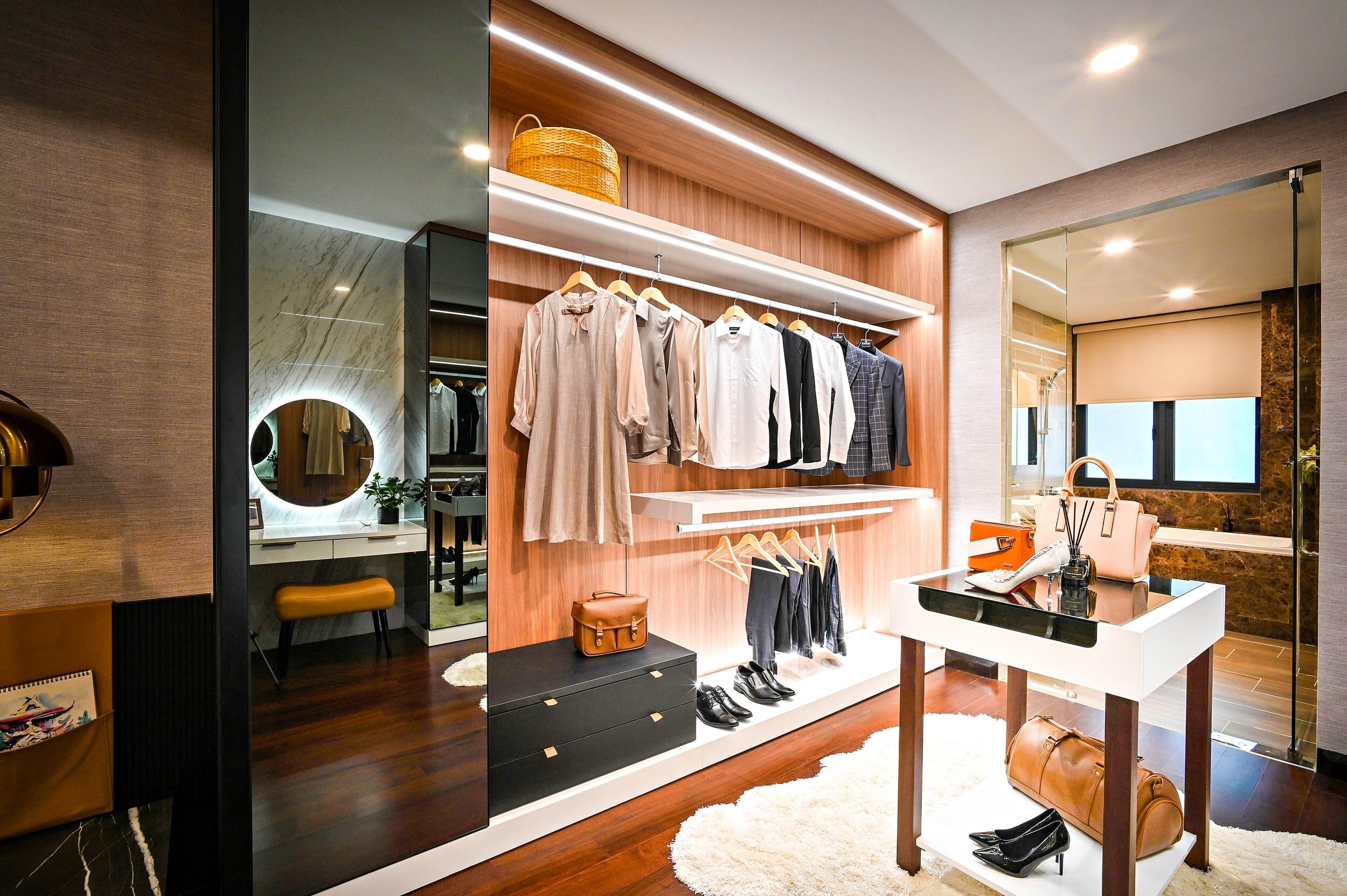8 Ways To Maximise Storage In Your Bedroom.
If you have little to no space in your bedroom, you really have no choice but to get creative with how you store your belongings. Thankfully, there are a ton of ways you can make your limited space work for you. Here are our top 8 tips to help you maximise storage in your bedroom.
If you have little to no space in your bedroom, you really have no choice but to get creative with how you store your belongings. Thankfully, there are a ton of ways you can make your limited space work for you. Here are our top 8 tips to help you maximise storage in your bedroom.
Choose a bed frame that allows you to have storage underneath the bed.
1. Maximize Under The Bed Storage.
Simply put, this is one of the smartest and easiest ways to add a whole area of storage to your sleep space. If you don’t currently have any storage, you’ve got several options: Buy a new storage bed, DIY an under-the-bed storage solution, or raise your current bed and add storage containers. The trick is to keep these storage solutions out of sight, which removes the visual clutter in your bedroom.
2. Organize Drawers To Free Up Space.
Think folding like Marie Kondo and using drawer dividers. If you have a chest of drawers, take some time first to declutter anything that’s not being used, then refold all of your items, and you will be surprised at how much more space you have. If you have out of season clothes such as that winter jacket you used pre-Covidd when heading in colder climates, consider vacuum packing these bulky items to save you precious drawer space.
3. Optimise Space In Your Wardrobe.
While you are looking at your drawers, don't forget to take a peek inside your wardrobe. How well organised is this precious space? If you can buy hangers that allow you to hang multiple pairs of trousers, for example, would that free up space within your wardrobe? Would adding more hanging bars or a couple of shelves make your wardrobe work harder for you? Before you invest in new furniture, consider how well the pieces have been working for you.
4. Consider Double Duty Furniture.
If possible, make each piece of furniture within your bedroom serve more than one function. You can use a chest as your night table; could your desk also serve as a vanity? You may need to get creative with what function your furniture serves within your bedroom.
Consider building in a wall of wardrobes to add in additional storage to your space.
5. Consider A Built In Wardrobe.
Carpentry can be expensive, so this may not be an option for everyone. However, if you have the space to install an even shallow or thin wardrobe along your walls, this will free up floor space. Choosing a light colour can help the wardrobe blend into the background rather than dominating the entire space. If your budget is tight, consider modular solutions such as the IKEA Pax system for your space or even head to second-hand marketplace Carousell for a pre-loved wardrobe that will fit into your space.
6. Store Only The Essentials In Your Bedroom.
This one may seem obvious; however, when you start to declutter your current drawers or wardrobe, you may find yourself asking, “does this item really belong in here?” You may, for example, be storing kids clothes in your master bedroom as they are too big for your child at the moment. Is this the best use of your space, or is there another place within the nursery to keep these? If you occasionally use your bedroom as a gym, does all the equipment need to live there, or would your dusty yoga mat be better stored in your bomb shelter?
Critically assess your clothing to see what is worth keeping and taking up storage space.
7. The Back Of The Door Is Useful Space.
The back of the door is often overlooked as a storage space, but nowadays, you can add so much storage there with a little creativity. Think shelving, shoe storage, baskets. When the door is open, you won’t even see them. Another great solution is rather than have a stand-alone full-length mirror, use a mirror that hangs over the back of the door.
8. Declutter Regularly.
Whilst decluttering can be cumbersome and time-consuming, doing it regularly, maybe every 6 months, will be more beneficial in the long run than simply adding new furniture to store new items. Donate or sell items you no longer need or use. Throw away or recycle broken items regularly so that you are consistently freeing up space within your home. If you haven’t used an item of clothing for 6 months, ask yourself, do you really want to keep it, or would you rather free up space for that new item you just purchased?
Pros & Cons Of A Walk In Wardrobe In Your HDB.
Walk-in wardrobes are popular choices for many homeowners in Singapore. They provide more space and can help you to stay organized too.
If you’re considering a walk-in wardrobe, you should know that there are various advantages and disadvantages to having one. We have what you need to know.
Walk-in wardrobes are popular choices for many homeowners in Singapore. They provide more space and can help you to stay organized too. This type of wardrobe is made of shelves, hanging space and sometimes drawers which are all used to store clothes as well as accessories. There are a number of pros and cons associated with the inclusion of a walk-in wardrobe – but the same can be said for all of the options available to you. To ensure that you’ve made the right choice for your home and needs, you will be required to weigh up each of the pros and cons. Some of these things you will be able to live with, others will be deal-breakers.
If you’re considering a walk-in wardrobe, you should know that there are various advantages and disadvantages to having one. Here’s what you need to know:
Pros
Organisation.
The upside to a walk-in wardrobe is organisation. For someone with a lot of shoes, dresses, etc., a regular wardrobe might be impractical. Walk-in wardrobes remove the need to play Tetris with clothes; no worrying that the whole wardrobe will spill out when you tug at a skirt. A walk-in also spreads out its inventory, so it’s easy to browse. No messing up the room while deciding which shoes/jeans / shirt to wear.
Privacy.
Another advantage to walk-ins is privacy. Some homeowners may choose to store jewellery in walk-ins, where it’s considerably safer than in a wardrobe. A walk-in is big enough for safe boxes if required; at the very least, it’s easier to conceal valuables in a large room than in a wardrobe. And if you’ve had anyone insist on using a room while you’re dressing, you’ll notice that a walk-in can actually help to ease congestion. Consider: a slow dresser can monopolise the bedroom for hours.
Maximise Possible Space.
Walk-ins also maximise the use of possible space. If you have a room with an odd shape, the little niches can be put to better use as a walk-in. You can use a walk-in to “square off “the niches, or even create triangular walk-ins. Both are more efficient than just hiding the spaces with more décor.
Cons
You need to be REALLY organized to have one.
If you're a naturally organized and put-together person, a walk-in wardrobe could work well for you. But if you are prone to bouts of messiness, you might want to steer clear, as this will be one more room that needs regular cleaning and sorting out! This is before we talk about the dust that gathers!
Pay More For Lighting & Carpentry
Since most walk-in wardrobes are dark, lighting is an issue. Be prepared to spend a bit extra on appropriate lighting. Task and accent lighting are a must, which translates to extra wiring and a higher power bill. Also, walk-ins involve a significant amount of carpentry. The furnishings of a walk-in are specific to its shape, so many of the shelves, cupboards, etc. cannot be purchased off-the-rack. This is especially true for smaller walk-in wardrobes, which cannot accommodate the inclusion of full-sized dressers or cupboards. That means custom carpentry work, which results in significant costs.
Sacrifice Space Elsewhere.
If you are renovating, you’ll find that the only way to add one of these wardrobes is to sacrifice space from elsewhere within the home. Often, it means that the other bedrooms get a little smaller, that your ensuite isn’t as luxurious as it could be or that your living space is left with awkward niches. If you can live with this, go for it!
Empty shelves will encourage extra spending.
If you don't have enough clothing to fill all of the shelves in your walk-in wardrobe, you might find yourself giving in to bad shopping habits, in a bid to justify the room!
Walk-in wardrobe Tips.
Still, have your heart set on a luxurious walk-in space? Here are a few tips to make space for a walk-in wardrobe in your compact home.
Look At The Corners.
Corners are often dead spaces that go to waste in a room, but looking at them in the context of building a walk-in wardrobe might mean you’ve found the perfect role for the corner. Consider developing your wardrobe plan around the corner, making use of a customisable layout and clever partition ideas to ward off future organisational woes.
2. Use Vertical Space.
Vertical space allows you to store more no matter how small a space you’re dealing with. Applying this trick while designing a wardrobe allows homeowners to make use of available space. Hangers, open shelves and sliding door wardrobes leave extra square footage to actually be able to walk in. Loft storage can serve as hideaways for seasonal or bulky items– this way, your wardrobe remains largely clutter-free.
3. Skip the Doors on Your Regular wardrobe instead.
Here’s a clever way to make a regular wardrobe seem like a walk-in. Skip the doors and make the compartments deep enough to stand in. This trick magics a walk-in wardrobe out of what was once a regular wardrobe, just by skipping the doors and leaving the shelves open.










